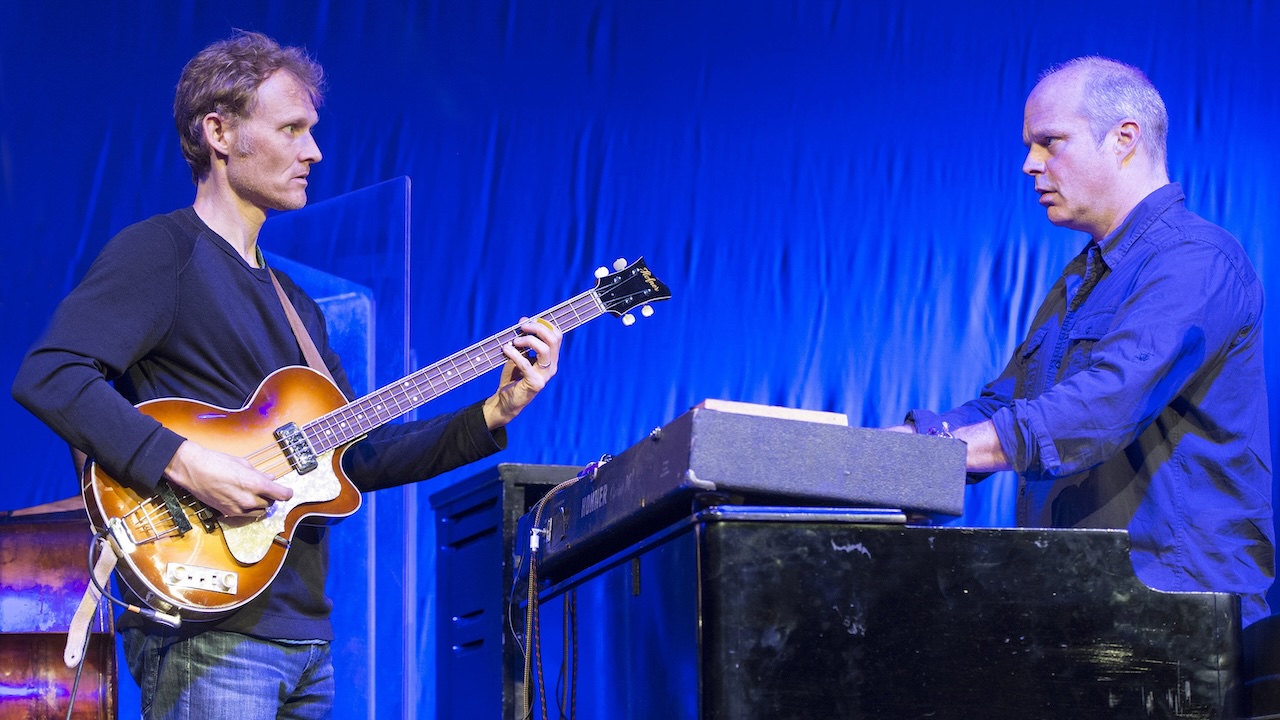“When called for, I try to get into that ‘stoopid’ mindset, like not even knowing the names of the strings. Physically, I'll even use a cruder, rougher approach”: Chris Wood unpacks his playing – both schooled and unschooled – with Medeski, Martin & Wood
Leaning on a vintage Fender and an old Ampeg, Chris Wood indulged his tone addictions on Medeski, Martin & Wood's Uninvisible

The booming underground jam-band scene has brought fringe-fresh, format-busting sounds into all corners of contemporary music – so not surprisingly, it's had the same effect on the bass side of things. A case in point is Chris Wood of Medeski Martin & Wood, the veteran avant-groove New York trio that has been anointed one of cornerstones of the jam nation.
Ponder any of the current trends in bassdom – feel over flash, jams as opposed to set compositions, doubling on electric and upright, retro gear and grooves, low-end-loaded mixes over full-range bite- and Wood fits the profile.
But his gift goes deeper than en vogue vamps. His extensive jazz training and ‘downtown’-sharpened instincts enable him to distinguish subtle shadings both in the sounds of the electric and acoustic bass. His resulting visionary spin has brought the concept of groove into a whole new light.
Wood got his first musical impulse at age 12, when he took to a Gibson-copy bass guitar. With the guidance of a local teacher and his high school band director – who also encouraged him to play upright – and with the groovy sounds of Larry Graham, James Jamerson, Jaco, Charles Mingus, and Cachao filling his ears, he headed to the New England Conservatory of Music.
There, he experienced mind-expanding jazz studies via one-on-one sessions with Dave Holland, lessons with pianist Geri Allen, and performances with drummer Bob Moses’ band of young genre-crossing musicians, including John Medeski.
Wood and Medeski moved to Manhattan in 1991, figuring on careers as straightahead jazz sidemen with their antennae up. That's when they hooked up with Billy Martin on a trio gig at the Village Gate. Martin's organic style, shaped by his stints with downtown heroes John Zorn and John Lurie, ignited a like-minded approach in Wood and Medeski, and MMW was born.

Soon the trio took to the road in Martin's old Ford van, hitting coffee houses and small rock clubs and building a new fan base along the way. More than thirty years later, they've brought live jazz to a large, more mainstream audience, while Wood has inspired a legion of jam-scene-initiated bassists to take on upright.
Get The Pick Newsletter
All the latest guitar news, interviews, lessons, reviews, deals and more, direct to your inbox!
On MMW's tenth disc, Uninvisible, Wood was on peak form on both instruments. His retro-rooted boogaloo P-Bass parts sparkled with post-Millennium polish, while his hip-hop upright lines twisted with Mingus-like bravado.
The following interview from the Bass Player archives took place in June 2002.
What was the concept for Uninvisible?
“We had the idea of a dub record – but really we just wanted something that had a consistent groove throughout. As always, we jammed and came up with material and recorded the core tracks at Shacklyn, our Brooklyn studio, with Scotty Hard, our producer. From there, we brought in guests who we felt would augment the music.
“We've found that if the music is organic enough it's amazing how you can add and combine elements. That's why we play the way we do: We try to leave open possibilities for new things to happen that we wouldn't even think of.”
The opener, Uninvisible, has a cool variations-on-a-theme bassline.
“We're big believers in the magic that occurs the first time you play something, so we try to keep that and build on it. This tune is a good example; I'm literally developing my bass part as you hear it.
“I had my '65 P-Bass going through an Electro-Harmonix Micro Bass Synthesizer, and I'm just reacting to the dirty, sub-octave sound. I was thinking along the lines of the Jackson 5's I Want You Back, with Wilton Felder on bass applying the Jamerson trademark of never playing quite the same thing twice.”
What can you practice to open up that side of your playing?
“It's valuable to spend some practice time playing completely freely, with no rules; just experiment with sounds and techniques that you don't normally work on. You'll discover ideas you wouldn't have otherwise, and you'll learn what it feels like to not be attached to anything you're supposed to play.
“That's important to get familiar with, because then you can bring it into a more structured musical format while retaining that sense of freedom and of being completely relaxed and open – almost like the instrument is playing itself.”
How do you feel about MMW's seminal status in the jam-band movement?
“I used to feel a little weird about it because I felt it was reflecting on our music, but now I realize it's just a description of a scene – a convenient marketing label for bands on the fringe or in the cracks. The common thread is improvisation, based on a band's particular influences. That said, it has been wonderful for us; we're grateful for the wide-ranging audiences we get to play for.”
How did Your Name Is Snake Anthony, with Col. Bruce Hampton's spoken part, come together?
“We called Bruce, who we've known forever, and asked him to contribute. He sent us a DAT with that story on it. We had an improvised piece of music that wasn't complete, so we decided to put his voice over it. It has become an MMW tradition; we did that with a Steve Cannon spoken piece on Combustication, and we even took a solo Sun Ra saxophonist Marshall Allen played for us on The Dropper and used it on a different track.
“Snake Anthony is Bruce's name for MMW because Anthony is John's middle name. And he makes all kinds of offbeat references – such as ‘small Japanese woman,’ which refers to our love of Japanese food.”
Take Me Nowhere and Ten Dollar High feature your upright work.
“On both of those I actually re-did the original electric bass parts at Bearsville. Nowhere was an improvised tune, but I didn't like the bass sound. I added the upright part, and I think it ended up improving the whole piece; the bass rides the fine line of making melodic statements while keeping the groove going.
“Ten Dollar High was a progression by John we were fooling around with, and at some point someone said, ‘Okay that's fine,’ – but I felt my part wasn't quite there, so I went back in later. The upper-register solo stuff at the beginning is just me reacting to the tune while overdubbing upright.”
You mention that fine line – how do you decide when to stay back and groove and when to step forward in more of a solo vein?
“Our songs are based on collective improvisations, so I'm pretty much always functioning in the dual role of providing the groove and stepping forward when there's a place that calls for it. Aside from my featured solo spot, our concept is that we aspire to improvise all the time, but in a groove context.”
How did you get the raw sound on I Wanna Ride You?
“I always wanted to get a tone like that, and this was the right tune to try it out on. I used my 63 P-Bass with the tone knob all the way up. Then we put it through my old B-15 turned up real loud, so you can feel the way the tubes compress the sound. It's a strange, nasal tone that reminds me of '60s boogaloo tracks. John wrote that piece beforehand; he brought it in and showed us the changes and some key lines, but the vamp sections are more open.”
You get a contrasting P-Bass sound on Smoke, which rides your bass melody.
“That's actually the same bass; we were jamming and messing around with Jimi Hendrix's Fire, and we ended up playing it slow, hence the name Smoke.
“The opening figure develops into counterpoint with John's organ line, and the track becomes more conversational than improvisational. That's something we do a lot, inspired by folks like James Brown, Sly & the Family Stone, and Fela Kuti. In their bands there was a certain way all of the parts fit together and all of the rhythms combined to form a counterpoint that created the overall rhythm.”
Retirement Song has an interesting sonic hue.
“That was a slightly different approach and a challenge. First Billy built up a drum and percussion track via overdubs. Next I had to go in and – inspired by Billy's tracks – create a bassline that established the mood, harmony, and song form. Then John built up the harmonies and added melodic context.
“We did this once before on Hey-Hee-Hi-Ho, from Combustication. I played upright here, but I was thinking about some of the African fretless bassists, like Bakithi Kumalo and his sliding lines with Paul Simon.”
Your feel is loose and almost sloppy on Nocturnal Transmission.
“The way we describe that concept is to play ‘stupid,’ or ‘stoopid’. It refers to playing like someone from the street as opposed to sounding like a schooled musician. Marc Ribot had a huge influence on me in that way. He was the first artist I toured with, and at one point he had me playing guitar because he wanted someone who wouldn't fall back on all the guitar clichés.
“When called for, I try to get into that mindset, like not even knowing the names of the strings. Physically I'll even use a cruder, rougher approach; I may keep my left hand in one position and play mostly root-5-octave lines, and I'll use only my index finger to pluck the strings.”
That's a difficult space for a schooled bassist to get into.
“Schooled musicians are often programmed to think that all the hours they put into their instrument means they should play it that way. There's a fear of taking risks or making mistakes. But that's limiting, because sometimes when you make a mistake, it's the hippest thing you play.
“In MMW we find a lot of the times when something happens that we didn't expect, it's the best part. That's how we discover new sounds. It's the old ‘ultimately, there's no such thing as a wrong note’ adage.”
Chris Jisi was Contributing Editor, Senior Contributing Editor, and Editor In Chief on Bass Player 1989-2018. He is the author of Brave New Bass, a compilation of interviews with bass players like Marcus Miller, Flea, Will Lee, Tony Levin, Jeff Berlin, Les Claypool and more, and The Fretless Bass, with insight from over 25 masters including Tony Levin, Marcus Miller, Gary Willis, Richard Bona, Jimmy Haslip, and Percy Jones.
“I asked him to get me four bass strings because I only had a $29 guitar from Sears”: Bootsy Collins is one of the all-time bass greats, but he started out on guitar. Here’s the sole reason why he switched
“I got that bass for $50 off this coke dealer. I don’t know what Jaco did to it, but he totally messed up the insides!” How Cro-Mags’ Harley Flanagan went from buying a Jaco Pastorius bass on the street to fronting one of hardcore’s most influential bands
















